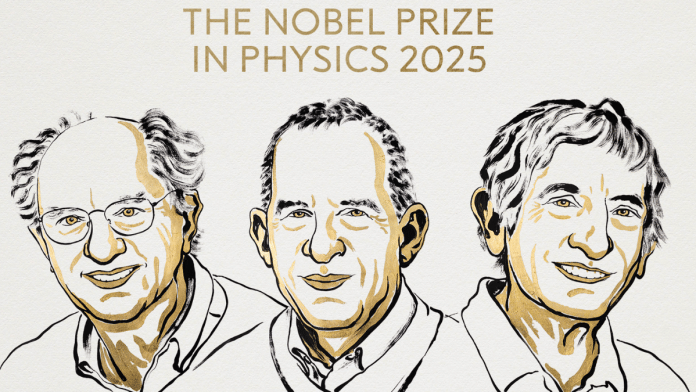Bengaluru: The 2025 Nobel Prize in Physics has been awarded to three American scientists for a series of experiments conducted in the 1980s on quantum mechanics. They experimentally showed that quantum mechanics can govern even large collective systems (or macroscopic systems) and not just microscopic elements like atoms and subatomic particles.
The three physicists who have won the award for their ground-breaking work are: John Clarke, University of California; Michel H. Devoret, Yale University and University of California and John M. Martinis, University of California.
“I am stunned. We had not realised it anyway; this might be the basis for a Nobel Prize,” Clarke said in a phone interview with journalists present at the award ceremony. He also mentioned that their work in many ways is the basis for further developments in quantum computers.
The Nobel Committee acknowledged the International Year of Quantum Physics—a centenary celebration of the field—and highlighted the relevance of this year’s award in that context.
Their work is a milestone in quantum physics as it experimentally validated many of the theoretical predictions put forward by giants in quantum mechanics such as Erwin Schrodinger, Paul Dirac and Werner Heissenberg.
In a press statement, Nobel Committee for Physics Chair Olle Eriksson said, “It is wonderful to be able to celebrate the way that century-old quantum mechanics continually offers new surprises. It is also enormously useful, as quantum mechanics is the foundation of all digital technology.”
Göran Johansson, a member of the Nobel Committee for Physics, said, “This brings quantum physics from the subatomic world onto a chip.”
Also Read: Nobel-winning quantum physicist Max Born once taught at IISc. His 6 months in India were bittersweet
Breaking barriers
In 1987, the three physicists published the results in Physical Review B, which confirmed Quantum Mechanical Tunnelling, a phenomenon where particles escape an energy barrier which is impossible according to classical physics.
Through the series of experiments, they demonstrated quantum properties in electrical circuits by demonstrating the presence of electrical current even at zero voltage at a small circuit junction.
“This brings quantum physics from the subatomic world onto a chip.”
Göran Johansson, member of the Nobel Committee for Physics, speaks about the research behind the 2025 physics prize, which demonstrated the bizarre properties of the quantum world in a system big enough to be… pic.twitter.com/TkJRirfgSR
— The Nobel Prize (@NobelPrize) October 7, 2025
Although the experiment they designed was macroscopic in nature (systems large enough to be seen, and not just like atoms or particles), it demonstrated quantum properties (typically observed only at microscopic scales), by allowing current to flow even in a zero-voltage state.
The theoretical support for their work goes back to 1926 when Erwin Schrodinger published his famous equation in quantum mechanics that governs the strange tunneling where a particle passes the forbidden energy barrier.
By 1973, electron tunneling discoveries were found in semiconductors and superconductors. But the finding was not experimentally validated at macroscopic quantum state in electrical circuits.
The core challenge addressed by this year’s Nobel winners was to find one such evidence. The theory to the challenge was already formulated by Anthony Legget in 1978 who suggested that quantum behaviour can occur in macroscopic systems.
The core challenge addressed by the laureates—observing quantum behavior in macroscopic systems—was formulated in 1978 by Anthony Leggett, who suggested Macroscopic Quantum Tunneling (MQT) might be realised in superconducting circuits.
The laureates were able to independently determine all necessary parameters for demonstration of passage of current even in the absence of a driving voltage which translates as passage of electrons even when a barrier is present.
The experiment proved that a circuit could be sufficiently isolated to observe these macroscopic quantum effects, establishing foundation for later developments of superconducting quantum bits.
Superconducting quantum bits form the fundamental building blocks of quantum computers as they exist in different states during the operation as opposed to classical bits which only have two states (on state or off state). They operate at extremely low temperatures for the atoms to exhibit quantum effects.
The Nobel committee noted that this year’s Nobel Prize in Physics has provided opportunities for developing the next generation of quantum technology, including quantum cryptography, quantum computers and quantum sensors.
In the press meet at the award ceremony, lots of questions were related to the application of the experiments.
The committee quoted Paul Dirac, a founding figure in quantum mechanics and Nobel laureate, to emphasise that science always serves society, and that today’s theories can benefit humanity even if the full answers are not yet known.
(Edited by Ajeet Tiwari)






